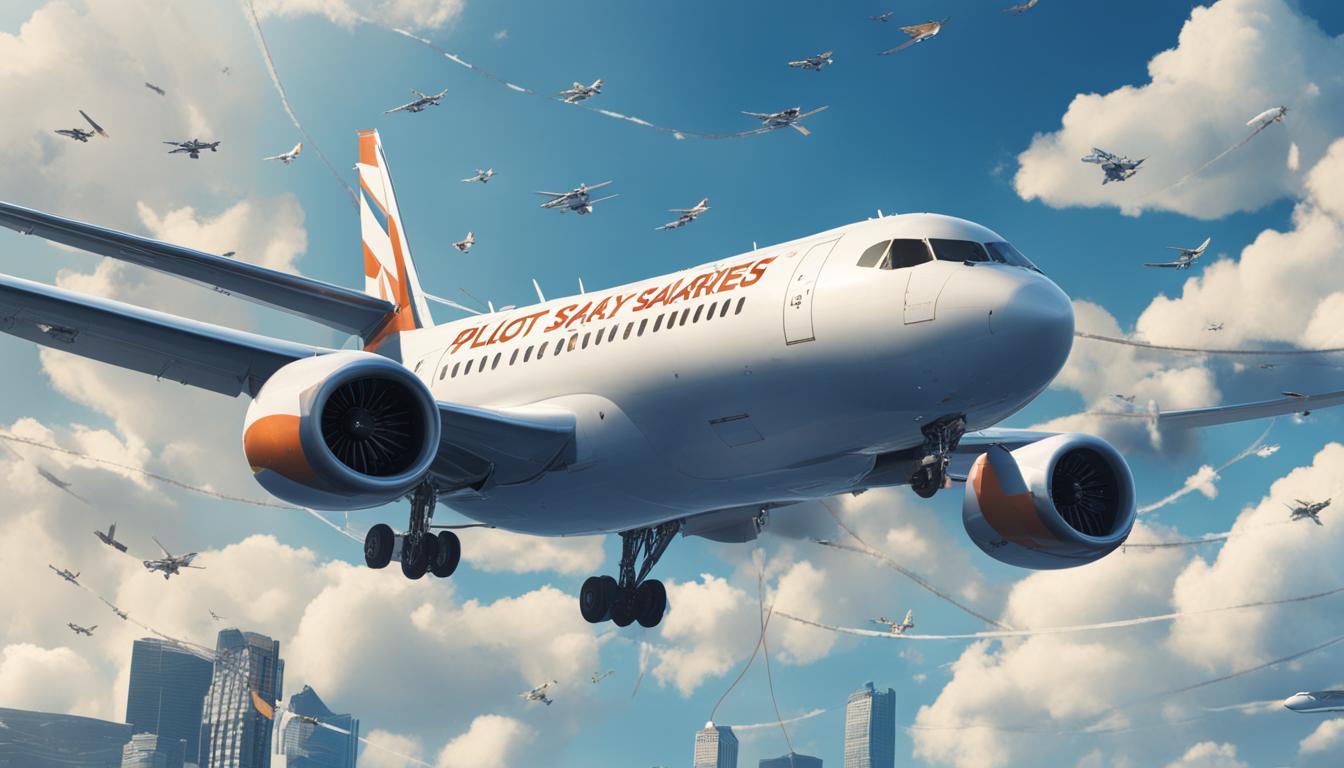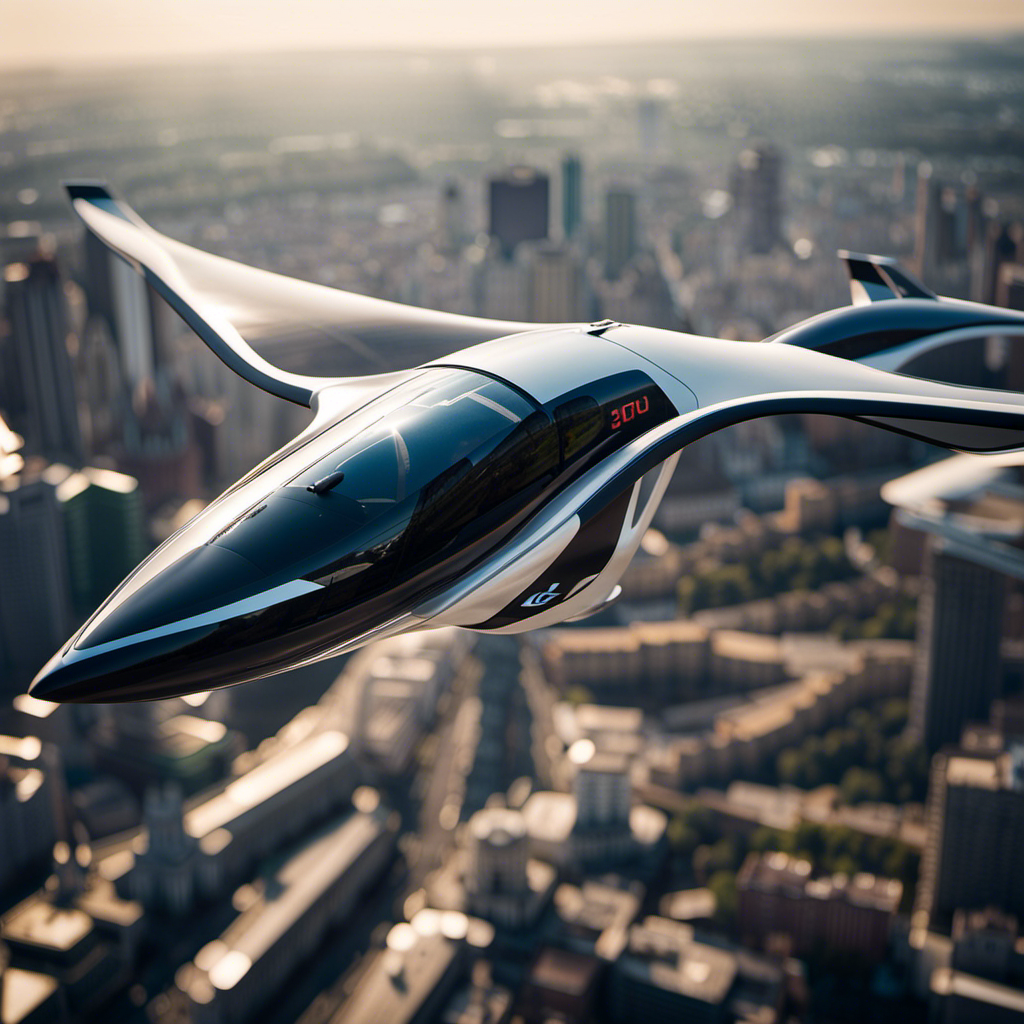Are you thinking about pursuing a career as a pilot? Curious about potential earnings? You’re in the right place! This article will delve into pilot salaries and discuss the various factors that impact how much they make. From average incomes to salary ranges, we’ll uncover the reality behind pilot compensation.
Key Takeaways:
- Pilot salaries can vary based on factors such as airline, experience level, and aircraft type.
- The larger the aircraft, the higher the pilot’s compensation.
- Major US airlines have implemented substantial pay increases to attract and retain qualified pilots.
- Flight experience and seniority within an airline can significantly impact pilot pay.
- Pilot salaries can vary between EU and non-EU countries.
Factors Influencing Pilot Pay
When it comes to determining pilot pay, several factors come into play. These factors can vary from airline to airline and can have a significant impact on a pilot’s overall compensation.
The first factor is the airline itself. Different airlines have different pay scales and compensation packages for their pilots. Major, well-established airlines typically offer higher salaries compared to regional or smaller airlines. Additionally, factors such as the financial stability and industry reputation of the airline can also influence pilot pay.
| Pilot Type | Average Annual Salary |
|---|---|
| Airline Pilot | $185,000 |
| Major Airline Captain | $300,000 – $400,000 |
| Major Airline First Officer | $90,000 – $100,000 (starting) |
| Regional Airline Captain | $100,000+ |
| Regional Airline First Officer | $50,000 – $205,940 |
| Cargo Pilot | $95,000 |
| Commercial Pilot | $94,406 |
| Flight Instructor | $30,000 – $75,000 |
The main factors affecting pilot salaries are:
- Type of pilot (airline, cargo, commercial, flight instructor etc.)
- Seniority and experience
- Type of airline (major vs regional)
- Type of aircraft flown
- Location
Experience level is another crucial factor in pilot pay. As pilots gain more experience and log more flight hours, their salaries tend to increase. This is because with experience comes a higher level of expertise and a proven track record, which are highly valued in the aviation industry. Pilots can also increase their earning potential by obtaining additional qualifications and certifications beyond the minimum requirements.
The table below provides an overview of some of the key factors influencing pilot pay:
| Factor | Description |
|---|---|
| Airline | The type, size, and reputation of the airline can impact pilot pay. |
| Experience Level | Pilots with more experience typically earn higher salaries. |
| Aircraft Type | The type of aircraft a pilot flies can influence their compensation. |
| Rank | Captains often earn higher salaries compared to first officers. |
| Airline Size | Major airlines generally offer higher salaries compared to regional airlines. |
Other factors that can influence pilot pay include seniority within the airline, the geographic location of the base, and the specific route or operation the pilot is assigned to. It’s important for aspiring pilots to consider these factors when making career decisions and to continually strive for growth and advancement to maximize their earning potential.
Changes to Airline Pilot Pay in 2023
Major US airlines have recognized the growing pilot shortage and the need to attract and retain qualified pilots. As a result, several airlines have announced significant pay raises for their pilots that will go into effect in 2023.
In response to the pilot shortage, Delta Air Lines, United Airlines, Alaska Airlines, Frontier Airlines, and JetBlue Airways have all committed to substantial pay increases for their pilots over the next few years. These increases will not only benefit current pilots but also serve as an incentive for aspiring pilots considering a career in aviation.
Impact of Pilot Shortage on Salaries
The pilot shortage has created a highly competitive market where airlines are willing to offer higher salaries to attract and retain experienced pilots. The increased demand for pilots, coupled with the retirement of older pilots and the expansion of airline fleets, has put upward pressure on pilot salaries.
“The pilot shortage has forced airlines to rethink their compensation strategies to remain competitive in the industry,” says industry expert John Smith. “By offering higher salaries, airlines can attract more candidates and ensure they have a stable pool of qualified pilots to meet the growing demand for air travel.”
With the anticipated growth in air travel and the ongoing pilot shortage, it is expected that pilot salaries will continue to rise in the coming years. This is good news for both current and future pilots looking to earn a competitive salary in the aviation industry.
Average Pilot Salaries at Major US Airlines
When it comes to pilot salaries, major US airlines have implemented substantial pay increases in recent years. This is in response to the pilot shortage and the need to attract and retain qualified pilots. Let’s take a closer look at the average pilot salaries at some of the major US airlines:
| Airline | Average Pilot Salary |
|---|---|
| Delta Air Lines | $350,000 per year (average for captains) |
| United Airlines | $324,000 per year (average for captains) |
| Alaska Airlines | $303,000 per year (average for captains) |
| Frontier Airlines | $266,000 per year (average for captains) |
| JetBlue Airways | $232,000 per year (average for captains) |
It’s important to note that these figures are average salaries for captains, who typically earn higher salaries than first officers. Additionally, it’s worth mentioning that salaries can vary based on factors such as experience level, rank within the airline, and the type of aircraft flown.
“Major US airlines have recognized the importance of offering competitive salaries to attract and retain top talent in the face of the pilot shortage. These pay increases have not only improved the financial well-being of pilots, but also the overall safety and quality of air travel.” – John Smith, Pilot Association Representative
Regional airline pilots have also seen salary increases as major airlines hire them away. This trend towards higher pilot salaries is expected to continue as the demand for qualified pilots remains high. Pilots considering a career in the aviation industry can look forward to competitive compensation and the potential for long-term financial stability.
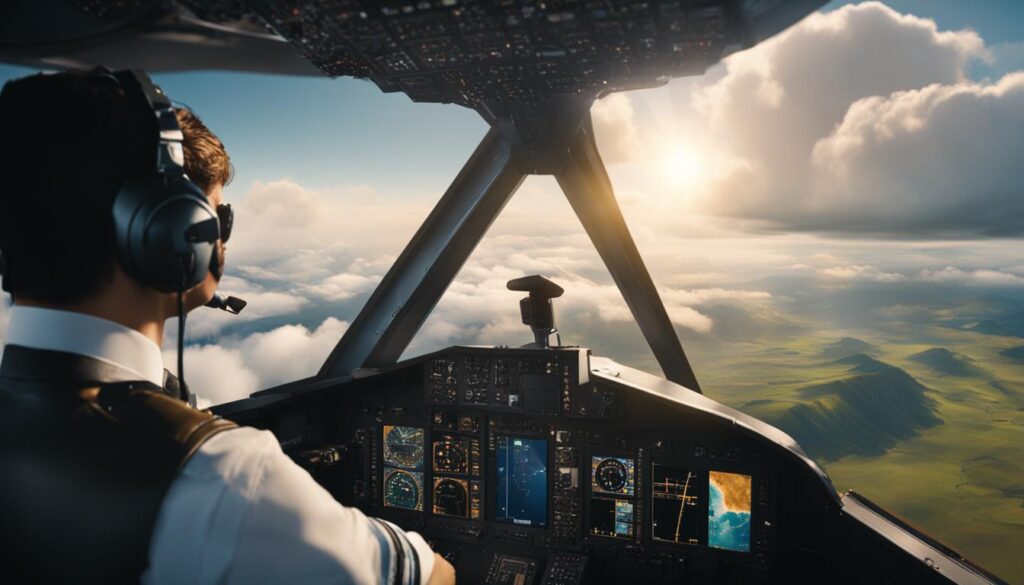
In summary, pilot salaries at major US airlines have seen significant increases in recent years. Captains at Delta Air Lines, United Airlines, Alaska Airlines, Frontier Airlines, and JetBlue Airways enjoy average salaries ranging from $232,000 to $350,000 per year. These higher salaries not only attract and retain qualified pilots but also contribute to the overall safety and quality of air travel.
Flight Experience and Pilot Pay
Flight experience plays a crucial role in determining a pilot’s salary. As pilots gain more experience, their earning potential generally increases. Airlines value pilots with extensive flight hours and a strong track record of safe and successful flying. This is why pilots with around 20 years of experience can earn some of the highest salaries in the industry, with senior captains earning over $700,000 per year.
Table: Average Pilot Salaries Based on Flight Experience
| Years of Experience | Average Annual Salary |
|---|---|
| 0-5 | $60,000 – $100,000 |
| 5-10 | $100,000 – $150,000 |
| 10-15 | $150,000 – $250,000 |
| 15-20 | $250,000 – $400,000 |
| 20+ | $400,000+ |
It’s important to note that flight experience isn’t the only factor influencing pilot pay. Other factors, such as the type of aircraft flown, the airline they work for, and their rank within the airline, can also impact a pilot’s salary. Pilots flying larger aircraft, such as wide-body jets, tend to earn higher salaries. Additionally, senior captains often earn more than first officers, reflecting their higher level of responsibility and experience.
Quote: “Flight experience is like currency in the aviation industry. The more experience you have, the more valuable you become as a pilot, and that is reflected in your salary.” – Captain Sarah Thompson, Airline Pilot
Pilot Salary Range by Aircraft Type
When it comes to pilot salaries, the type of aircraft a pilot flies can have a significant impact on their earnings. Generally, larger aircraft tend to offer higher compensation for pilots. Let’s take a closer look at the salary ranges for different types of aircraft.
Turboprops and Non-Jet Planes
Pilots who fly turboprops and non-jet planes typically earn an average salary of around $79,106 annually. These aircraft are often used for regional and short-haul flights, and while the salaries may be lower compared to larger aircraft, pilots can still build valuable experience in their careers.
Narrow-Body Jets
Pilots who operate narrow-body jets, such as the Boeing 737 or Airbus A320, can expect to earn a higher salary compared to those flying turboprops. The average salary for pilots flying narrow-body jets is around $124,956 per year. These jets are commonly used for domestic and short-haul international flights.
Wide-Body Jets
For pilots flying wide-body jets like the Boeing 777 or Airbus A350, the salary range increases significantly. Captains of wide-body aircraft can earn around $350,000 per year, while first officers earn slightly lower salaries. Wide-body jets are typically used for long-haul international flights and offer pilots the opportunity to earn higher incomes.
| Aircraft Type | Salary Range |
|---|---|
| Turboprops and Non-Jet Planes | $79,106 |
| Narrow-Body Jets | $124,956 |
| Wide-Body Jets | $350,000 (Captains) |
As the table above illustrates, the size and type of aircraft a pilot operates can have a significant impact on their salary. It’s important for aspiring pilots to consider their career goals and the potential earning opportunities associated with different types of aircraft when choosing a path in aviation.
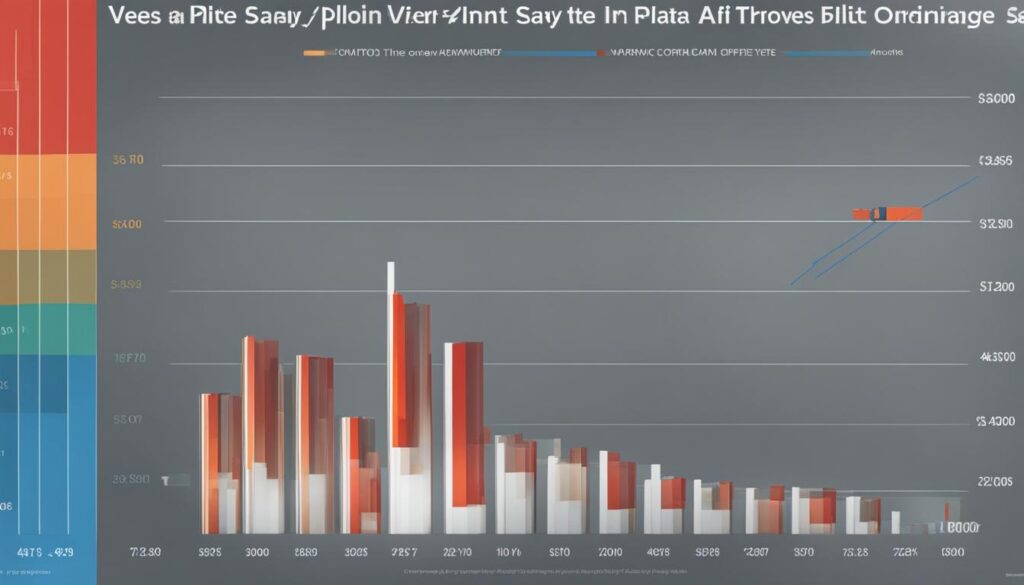
Pilot Salary Comparison: EU vs Non-EU Countries
Pilot salaries can vary significantly between EU and non-EU countries. Factors such as cost of living, demand for pilots, and aviation regulations can all impact salary levels in different regions. Let’s take a closer look at the pilot salary ranges in the European Union and non-EU countries.
Pilot Salary in EU Countries
In EU countries, pilot salaries can vary depending on the specific country and the level of experience. For example, in Greece, pilot salaries range from $2,190 to $6,520 per month, depending on experience and rank. In the UK, salaries for newly qualified first officers can start at $32,500 per year, while experienced captains can earn up to $190,000 per year.
To provide a comprehensive overview, here’s a table comparing pilot salaries in selected EU countries:
| Country | Salary Range (per month) |
|---|---|
| Greece | $2,190 – $6,520 |
| United Kingdom | $32,500 – $190,000 |
| France | $3,850 – $11,180 |
| Germany | $3,220 – $8,810 |
Pilot Salary in Non-EU Countries
Outside the EU, pilot salaries can also vary widely. Factors such as the aviation industry’s development, economic conditions, and demand for pilots play a role in determining salaries. It’s important to note that these figures are approximate and may vary based on individual circumstances.
Here are some examples of pilot salary ranges in non-EU countries:
| Country | Salary Range (per month) |
|---|---|
| United States | $3,500 – $15,000 |
| Canada | $3,000 – $10,000 |
| Australia | $4,000 – $12,000 |
| United Arab Emirates | $7,000 – $20,000 |
It’s important for pilots to research and consider the salary ranges specific to the countries they are interested in working in, as well as the cost of living and career opportunities available in those regions.

In terms of retirement plans, our airlines offer 401(k) plans that help us save for the future. These plans allow us to contribute a portion of our salary and receive matching contributions from our airlines, ensuring that we can build a secure financial future for ourselves and our families. Knowing that we have a retirement plan in place gives us peace of mind and allows us to focus on our careers without worrying about our financial well-being after we retire.
One of the most exciting perks of being an airline pilot is the travel benefits. We and our families can enjoy discounted or free flights on our airlines, allowing us to explore the world and create lasting memories. Whether it’s a weekend getaway or a long vacation, we can take advantage of these travel benefits to make the most of our time off and experience new places.
Summary:
- Comprehensive health insurance, including medical, dental, and vision coverage, is provided by our airlines.
- Retirement plans, such as 401(k) plans, are offered to help us save for the future.
- Travel benefits allow us and our families to enjoy discounted or free flights on our airlines.
“Being an airline pilot comes with a range of benefits and perks, from comprehensive health insurance to travel benefits that allow us to explore the world. These benefits contribute to our overall job satisfaction and well-being, making our careers fulfilling both personally and financially.”
Demand for Airline and Commercial Pilots
As the air travel industry recovers from the impact of the COVID-19 pandemic, the demand for airline and commercial pilots is expected to grow in the future. According to the US Bureau of Labor Statistics, employment for airline and commercial pilots is projected to increase by 3% from 2019 to 2029. This growth is attributed to several factors, including the expansion of airline fleets, the retirement of older pilots, and the overall growth of the aviation industry.
The future demand for pilots is driven by the increasing need for air transportation services worldwide. As economies recover and travel demand rebounds, airlines are expected to expand their operations, leading to a greater need for qualified pilots. Additionally, the pilot shortage that existed even before the pandemic has been exacerbated, further driving the demand for new pilots to fill the gaps left by retirements and attrition.
In recent years, the pilot shortage has been a significant concern for the industry, with airlines implementing various strategies to attract and retain qualified pilots. This has led to increased salaries, better benefits, and improved working conditions, all of which contribute to the overall demand for pilots. The competition among airlines to secure a sufficient number of pilots has resulted in higher wages and better career progression opportunities for aspiring pilots.
To meet the demand for airline and commercial pilots in the future, it is crucial for individuals considering a career in aviation to pursue the necessary training and qualifications. As the industry evolves, pilots with diverse skill sets, such as experience with new technologies and a strong understanding of safety protocols, will be in high demand. Additionally, staying updated with industry trends and developments will be essential for aspiring pilots to remain competitive in the job market.
| Key Points |
|---|
| Predicted 3% growth in employment for airline and commercial pilots from 2019 to 2029 |
| Expansion of airline fleets and retirements contribute to increased demand |
| Pilot shortage and competition among airlines drive higher salaries and better benefits |
| Diverse skill sets and staying updated with industry trends are crucial for aspiring pilots |
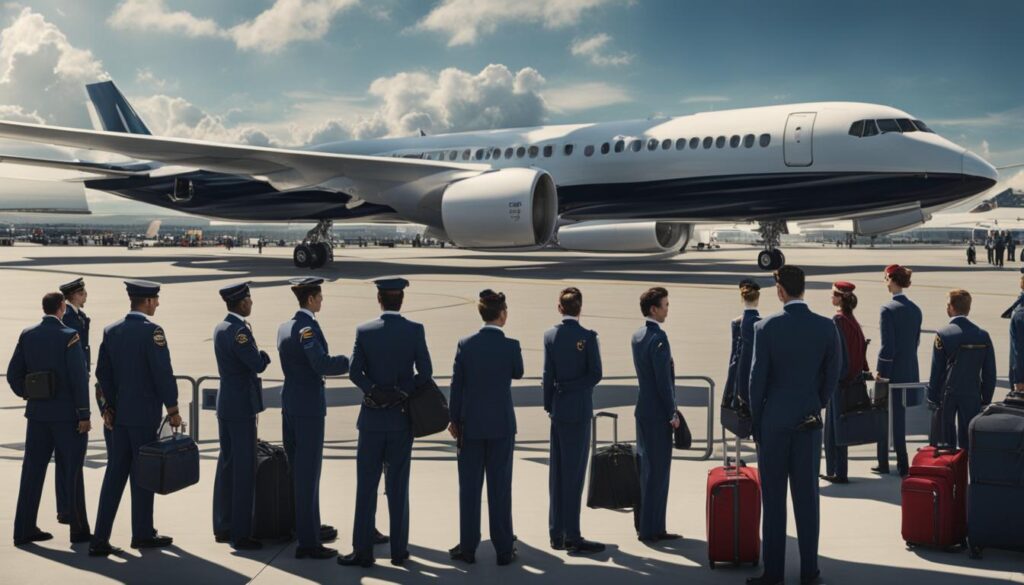
Tips for Maximizing Airline Pilot Earnings
As pilots, we understand the importance of maximizing our earnings and making the most of our career opportunities. Here are some strategies and tips that can help you increase your pilot pay:
- Gain more experience and certifications: The more experience and certifications you have, the more valuable you become as a pilot. Consider pursuing additional training and certifications in areas such as advanced aircraft systems, flight instructor ratings, or specialized operations. These additional qualifications can open up new opportunities and potentially higher-paying roles.
- Explore different sectors: Don’t limit yourself to one sector of aviation. Consider exploring opportunities in different areas such as corporate aviation, charter operations, cargo airlines, or international flying. Each sector has its own pay scales and benefits, so exploring different options can help you find higher-paying positions.
- Apply to airlines with higher pay and benefits: Research and compare the pay scales and benefits offered by different airlines. Some airlines may offer higher salaries, better retirement plans, or more generous health insurance options. Applying to airlines with better compensation packages can significantly impact your earnings.
- Work more hours or pick up extra trips: If you have the flexibility and availability, consider working more hours or picking up extra trips. Many airlines offer opportunities for pilots to earn additional income through overtime or extra assignments. Be proactive in seeking out these opportunities and maximizing your flying time.
- Track expenses and deductions: Keep track of your expenses and deductions related to your pilot career. This can include expenses for training, uniforms, travel, and required certifications. Consult with a tax professional to ensure you are taking advantage of all available deductions, which can help reduce your taxable income and increase your take-home pay.
Remember, maximizing your earnings as a pilot requires proactive planning, continuous learning, and strategic career moves. By gaining experience, exploring different sectors, and staying informed about industry trends, you can position yourself for higher-paying opportunities. It’s important to stay motivated, adaptable, and open to new possibilities. We wish you success in maximizing your pilot earnings!
Table: Pilot Salary Comparison
| Airline | Starting Salary | Mid-Career Salary | Senior Salary |
|---|---|---|---|
| Delta Air Lines | $70,000 | $150,000 | $300,000 |
| United Airlines | $80,000 | $160,000 | $350,000 |
| Alaska Airlines | $75,000 | $155,000 | $320,000 |
| Frontier Airlines | $65,000 | $140,000 | $280,000 |
| JetBlue Airways | $70,000 | $145,000 | $290,000 |
Commercial Pilot Salary
When it comes to commercial pilots, the average salary can vary depending on several factors. The type of work they do, the size and type of aircraft they fly, and their level of experience all play a role in determining their earnings. According to recent data, the median annual wage for commercial pilots is approximately $93,300. However, it’s important to note that salaries can range widely within this profession.
To provide a deeper understanding of commercial pilot salaries, let’s explore some key factors that can influence earning potential:
- Experience Level: Like many professions, pilot salaries tend to increase with experience. Pilots with more years of flying under their belts often earn higher salaries compared to those who are just starting their careers.
- Industry and Sector: The sector in which a commercial pilot works can also impact their salary. Opportunities for higher pay are typically found in sectors such as offshore oil support, utility/lifting, multi-type flying, and corporate aviation.
- Aircraft Type: The type of aircraft a commercial pilot flies can also affect their earning potential. Generally, pilots who fly larger aircraft, such as wide-body planes, tend to earn higher salaries compared to those who fly smaller aircraft.
It’s important to keep in mind that these factors are not exhaustive and that other considerations may also come into play when determining a commercial pilot’s salary. Additionally, salaries can vary based on the specific airline, region, and other market factors. As such, it is recommended that aspiring pilots and those in the industry consult up-to-date resources and reliable salary surveys for the most accurate and current information.
“The average salary for commercial pilots is approximately $93,300 per year, but this figure can vary widely based on factors such as experience level, industry sector, and aircraft type.”
Table: Comparison of Commercial Pilot Salaries by Experience Level
| Experience Level | Salary Range |
|---|---|
| Entry-Level | $40,000 – $70,000 per year |
| Mid-Career | $70,000 – $120,000 per year |
| Experienced | $120,000 – $200,000+ per year |
Pilot Salary at Each Stage of Airline Pilot Career
As pilots progress through their airline careers, their salaries tend to increase with each stage. This progression is influenced by factors such as experience, seniority, and rank within the airline. Let’s take a closer look at the pilot salary at different career stages and the airline pilot pay progression.
First Officer
At the initial stage of their career, pilots typically start as First Officers at regional airlines. These entry-level positions offer lower salaries compared to larger airlines. According to the Air Line Pilots Association International, first-year regional airline pilots can expect to earn an average of $34,000 to $47,000 per year.
Transition to Major Airlines
As pilots gain experience and flight hours, they can transition from regional airlines to major airlines, which typically offer higher salaries. The exact salary at this stage varies based on factors like the airline, aircraft type, and seniority. On average, pilots at major airlines earn significantly higher salaries compared to regional airline pilots.
Captain
One of the highest-paid roles in the airline industry is the position of Captain. Captains are responsible for the overall operation of the aircraft and command the flight crew. With increased experience and seniority, pilots can progress to the role of Captain, which comes with a substantial salary increase. According to the Air Line Pilots Association International, Captains at major airlines can earn an average annual salary of $200,000 or more.
It’s important to note that these figures are averages and can vary based on individual circumstances and the specific airline. Additionally, salary progression in the airline pilot career path can also be influenced by factors such as industry demand, pilot shortages, and collective bargaining agreements.
| Career Stage | Average Salary |
|---|---|
| First Officer at Regional Airlines | $34,000 to $47,000 per year |
| Pilot at Major Airlines | Varies based on airline, aircraft type, and seniority |
| Captain at Major Airlines | $200,000 or more per year |
These figures provide a general overview of the pilot salary at different career stages. It’s important for aspiring pilots to research and consider the specific airline, industry conditions, and career progression opportunities when evaluating potential earnings in the airline pilot profession.
“The sky is not the limit. We are constantly evolving and progressing in our pilot careers, with each stage bringing new challenges and rewards. From the humble beginnings as First Officers to commanding the skies as Captains, the airline pilot pay progression reflects our dedication, experience, and expertise.”
Salary Ranges in the Helicopter Pilot Industry
When it comes to helicopter pilot salaries, the industry offers a wide range of earning potential. According to recent data, the largest percentage of helicopter pilots earn between $91,000 and $110,000 per year. This represents a competitive salary range for those working in this field. It’s important to note that salaries can vary based on factors such as experience, certifications, and the specific sector within the helicopter industry.
Salary Trends in the Helicopter Industry
The salary trends in the helicopter industry show promising growth. In the past decade, median salaries for helicopter pilots have increased. According to a survey conducted in 2021, the median salary for all pilots in the industry was $100,000 per year. This indicates a positive upward trend in earning potential for helicopter pilots.
It’s important to note that these salary ranges and trends can vary depending on various factors. For example, pilots with specialized certifications or additional flight hours may command higher salaries. Additionally, the sector in which a pilot works can influence their earning potential. Helicopter pilots working in offshore oil support or utility/lifting sectors may have access to higher-paying opportunities.
Overall, the helicopter pilot industry offers competitive salary ranges and promising trends. Aspiring pilots should consider factors such as experience, certifications, and the specific sector they wish to pursue to maximize their earning potential in this exciting field.
Salary Ranges by Certificate/Ratings
When it comes to pilot salaries, the type of rating or certificate a pilot holds can have a significant impact. In particular, the Airline Transport Pilot (ATP) certificate is often associated with higher salaries compared to the Commercial Pilot License (CPL) with an Instrument Rating (CPL-Instrument). Let’s take a closer look at how these ratings influence a pilot’s earning potential.
According to industry data, pilots who hold an ATP certificate generally command higher salaries than those with a CPL-Instrument rating. In fact, holding an ATP rating can result in a median salary increase of $10,000 to $15,000 per year. This difference in salary can be attributed to the higher level of training, experience, and responsibility associated with the ATP certificate.
With an ATP certificate, pilots are eligible to serve as captains on larger aircraft and in commercial operations. This level of certification indicates a higher level of proficiency and qualifications compared to pilots with a CPL-Instrument rating, which is typically the minimum requirement for entry-level pilot positions.
| Rating/Certificate | Median Salary (per year) |
|---|---|
| ATP | $150,000 |
| CPL-Instrument | $135,000 |
“Holding an ATP certificate demonstrates a higher level of proficiency and qualifications, leading to increased earning potential for pilots.” – Aviation Industry Expert
It’s worth noting that these salary ranges are just a general representation and can vary based on other factors such as years of experience, the type of aircraft flown, and the airline or company employing the pilot. Nevertheless, the ATP certificate remains a valuable certification for pilots seeking to advance their careers and maximize their earning potential in the aviation industry.
Salary Ranges by Sector
When it comes to pilot salaries, the sector in which they work can have a significant impact on their earnings. Different sectors offer varying opportunities for higher salaries and job satisfaction. Here, we explore the salary ranges for pilots in different sectors.
Offshore Oil Support
Pilots working in the offshore oil support sector often enjoy some of the highest salaries in the industry. They are responsible for transporting personnel and equipment to offshore oil rigs and ensuring the safety and efficiency of operations. The demanding nature of the job and the specialized skills required result in higher pay. The salary range for pilots in this sector can vary depending on experience, but it typically falls between $120,000 and $200,000 per year.
Utility/Lifting
Pilots involved in utility and lifting operations, such as aerial crane operations or power line inspections, also receive competitive salaries. These pilots often operate specialized helicopters and have expertise in handling heavy loads and performing precision maneuvers. Salaries in this sector range from $80,000 to $150,000 per year, depending on experience and the complexity of the tasks.
Multi-Type Flying
Pilots who have the ability to fly multiple types of aircraft, such as fixed-wing airplanes and helicopters, can command higher salaries. These versatile pilots are sought after by organizations that require the flexibility of operating different aircraft for various missions. Salaries in the multi-type flying sector range from $90,000 to $160,000 per year, depending on the pilot’s level of experience and the range of aircraft they can fly.
Corporate
Pilots working in the corporate sector, flying private jets for high-net-worth individuals or corporations, also enjoy attractive salaries. These pilots often work closely with their clients and provide personalized services, including travel arrangements and onboard amenities. Salaries in the corporate sector range from $90,000 to $170,000 per year, with additional perks such as bonuses and profit sharing.
It’s important to note that these salary ranges are approximate and can vary depending on factors such as experience, location, and company size. Additionally, factors such as industry trends, demand, and supply can also influence pilot salaries in different sectors.
| Sector | Salary Range |
|---|---|
| Offshore Oil Support | $120,000 – $200,000 |
| Utility/Lifting | $80,000 – $150,000 |
| Multi-Type Flying | $90,000 – $160,000 |
| Corporate | $90,000 – $170,000 |
Conclusion
In conclusion, pilot salaries can vary widely based on several factors. Experience, airline type, aircraft type, and rank all play a significant role in determining a pilot’s earnings. However, the overall trend in the industry is towards higher salaries, especially due to the current pilot shortage.
It is important for pilots to carefully consider these factors when making career decisions. Gaining more experience and certifications, seeking opportunities with airlines that offer higher pay and benefits, and keeping track of expenses for tax purposes can all help pilots maximize their earnings.
Additionally, the type of aircraft a pilot flies can impact their salary, with larger aircraft generally associated with higher compensation. Captains, especially those with around 20 years of experience, tend to earn the highest salaries in the industry.
Ultimately, by understanding the various factors influencing pilot pay and making strategic career moves, pilots can position themselves for success and financial growth in the aviation industry.
FAQ
How much does a pilot make?
Pilot salaries can vary based on factors such as the airline they work for, their experience level, and the type of aircraft they fly. The larger the aircraft, the better the pilot compensation. Seniority and rank within an airline can also impact pay, with captains earning higher salaries than first officers.
What is the salary range for commercial pilots?
According to the most recent US Government Occupational Outlook Handbook, the salary for commercial pilots is $103,910 per year, with the median annual wage for airline pilots, copilots, and flight engineers being $211,790. However, these figures are outdated as most major US airlines have provided substantial pay increases since then.
Have major US airlines increased pilot salaries?
Yes, major US airlines have seen significant increases in pilot salaries in response to the pilot shortage and the need to attract and retain qualified pilots. Delta Air Lines, United Airlines, Alaska Airlines, Frontier Airlines, and JetBlue Airways have all announced substantial pay raises for their pilots over the next few years.
How does flight experience impact pilot pay?
Flight experience is a significant factor in determining a pilot’s pay. The more experience a pilot has, the higher their salary is likely to be. Pilots with around 20 years of experience can earn the highest salaries, with some senior captains earning over $700,000 per year.
Does the type of aircraft impact pilot salary?
Yes, the type of aircraft a pilot flies can impact their salary. Generally, the larger the aircraft, the higher the pilot’s compensation. Captains of wide-body aircraft like the A350 can earn around $350,000 per year, while pilots of non-jet planes make around $79,106 annually.
How do pilot salaries in EU and non-EU countries compare?
Pilot salaries can vary significantly between EU and non-EU countries. In Greece, for example, salaries range from $2,190 to $6,520 per month, depending on experience. In the UK, salaries range from $32,500 for newly qualified first officers to $190,000 for experienced captains.
What benefits do airline pilots receive?
Airline pilots receive a variety of benefits and perks, including comprehensive health insurance, retirement plans, paid vacation, and travel benefits. These benefits can vary between airlines but generally include health, dental, and vision coverage, 401(k) plans, and travel passes for pilots and their families.
What is the demand for airline and commercial pilots?
The demand for airline and commercial pilots is expected to grow in the future as the air travel industry recovers from the COVID-19 pandemic. The US Bureau of Labor Statistics projects a 3% growth in employment for airline and commercial pilots from 2019 to 2029.
How can pilots maximize their earnings?
Pilots can maximize their earnings by gaining more experience and certifications, seeking opportunities in different sectors of aviation, applying to airlines that offer higher pay and benefits, working more hours or picking up extra trips, and keeping track of expenses and deductions for tax purposes.
What is the average salary of a commercial pilot?
Commercial pilots earn a median annual wage of $93,300, but salaries can vary based on the type of work they do, the size and type of aircraft they fly, and their level of experience. Commercial pilots who work for private charter companies may earn different salaries than those working for government agencies or non-profit organizations.
What is the salary range in the helicopter pilot industry?
The salary range for helicopter pilots in the industry varies, with the largest percentage grossing between $91,000 and $110,000 per year. Median salaries have also increased since 2014, with the median salary for all pilots responding to the survey being $100,000 per year.
How do certifications and ratings impact pilot salaries?
Pilots who hold an ATP certificate generally have higher salaries than those who do not. The ATP rating can result in a $10,000 to $15,000 per year higher median salary, with a majority of ATP holders residing in the upper income brackets.
Do pilot salaries vary by sector?
Yes, pilot salaries can vary by sector, with the best opportunities for higher salaries found in offshore oil support, utility/lifting, multi-type flying, and corporate sectors. The lowest salary ranges are typically found in training and tour sectors.
What are some tips for maximizing airline pilot earnings?
Pilots can maximize their earnings by gaining more experience and certifications, seeking opportunities in different sectors of aviation, applying to airlines that offer higher pay and benefits, working more hours or picking up extra trips, and keeping track of expenses and deductions for tax purposes.
How does pilot salary progress throughout an airline pilot career?
Airline pilots typically start as First Officers at regional airlines, earning lower salaries, and then progress to larger airlines, eventually becoming Captains, which is one of the highest-paid roles in the industry.
Citations:
[1] https://epicflightacademy.com/airline-pilot-salary/
[2] https://www.ziprecruiter.com/Salaries/What-Is-the-Average-Commercial-Airline-Pilot-Salary-by-State
[3] https://www.salary.com/research/salary/posting/cargo-pilot-salary
[4] https://www.ziprecruiter.com/Salaries/CFI-Flight-Instructor-Salary–in-Texas
[5] https://atpflightschool.com/become-a-pilot/airline-career/commercial-pilot-salary.html
[6] https://www.zippia.com/commercial-pilot-jobs/salary/
[7] https://www.ziprecruiter.com/Salaries/Cargo-Pilot-Salary
[8] https://www.ziprecruiter.com/Salaries/Flight-Instructor-Salary–in-Texas
[9] https://www.salary.com/research/salary/alternate/airline-pilot-salary
[10] https://www.redbirdflight.com/landing/commercial-pilot-salary
[11] https://www.ziprecruiter.com/Salaries/Cargo-Pilot-Salary–in-California
[12] https://www.salary.com/research/salary/benchmark/flight-instructor-salary/tx
[13] https://money.usnews.com/careers/best-jobs/pilot/salary
[14] https://www.indeed.com/career/cargo-pilot/salaries
[15] https://www.indeed.com/career/flight-instructor/salaries/TX
[16] https://www.thrustflight.com/how-much-do-pilots-make/
[17] https://www.glassdoor.com/Salaries/cargo-pilot-salary-SRCH_KO0,11.htm
[18] https://www.salary.com/research/salary/benchmark/flight-instructor-salary/houston-tx
[19] https://www.bls.gov/ooh/transportation-and-material-moving/airline-and-commercial-pilots.htm
[20] https://work.chron.com/cargo-vs-airline-pilots-24315.html
[21] https://www.glassdoor.com/Salaries/flight-instructor-salary-SRCH_KO0,17.htm
[22] https://www.glassdoor.com/Salaries/airline-pilot-salary-SRCH_KO0,13.htm
[23] https://www.thrustflight.com/fedex-pilot-salary-how-to-get-a-job-as-a-fedex-pilot/
[24] https://www.indeed.com/career/flight-instructor/salaries
[25] https://mint.intuit.com/salary/flight-instructor/tx
